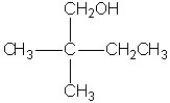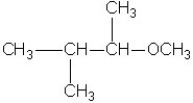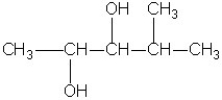Q60: Which of the following molecules is chiral?<br>A)3-pentanol<br>B)2-pentanol<br>C)3-bromopentane<br>D)2,2-dichlorobutane<br>E)cyclopentanol
Q61: Which compound has the lowest boiling point?<br>A)CH<sub>3</sub>CH<sub>2</sub>CH<sub>2</sub>CH<sub>2</sub>CH<sub>2</sub>OH<br>B)CH<sub>3</sub>CH<sub>2</sub>CH<sub>2</sub>CH<sub>2</sub>CH<sub>3</sub><br>C)CH<sub>3</sub>CH<sub>2</sub>CH<sub>2</sub>CH<sub>2</sub>OH<br>D)CH<sub>3</sub>CH<sub>2</sub>CH<sub>2</sub>CH<sub>3</sub><br>E)CH<sub>3</sub>CH<sub>2</sub>CH<sub>2</sub>OH
Q62: Which compound is a tertiary alcohol?<br>A)1-propanol<br>B)2-methyl-1-hexanol<br>C)2-methyl-2-hexanol<br>D)3-methyl-2-hexanol<br>E)3-hexanol
Q63: Which of the following compounds contains a
Q64: The common name of CH<sub>2</sub>(OH)CH<sub>2</sub>OH is<br>A)grain alcohol.<br>B)wood
Q66: Organic compounds which are sulfur analogs of
Q67: The symbol [O] written above a reaction
Q68: Treatment of the molecule shown with a
Q69: Alcohols,ethers,and phenols can be considered organic derivatives
Q70: Ether molecules are polar,but do not form




